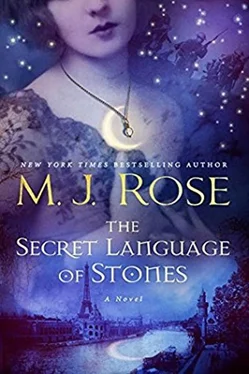Now, slowly walk to the sculpture’s feet and then around so you can view the piece’s other side. Let your eyes travel up from the ankles to the calves, the knees, the thighs. Surprised? Ah yes, so was I.
There in all their crude beauty are his genitals. Now, Ma chère, look at his chest. How is it possible? Beautiful female breasts as well as a fully formed penis.
Gaze on the face of The Sleeping Hermaphrodite. What a marvel, isn’t it? From some angles a lovely naked woman and from others a lusty young man. Curves and cravings.
According to scholars, this work was typical of Hellenistic art, designed to tease and provide surprise. The statue is a Roman antiquity found in 1608. Eleven years later Cardinal Borghese commissioned the great Italian sculptor Bernini to carve the sumptuous mattress as a base.
Do you know the story of Hermaphroditus, son of Hermes and Aphrodite? The water nymph Salmacis fell in love with the handsome boy and tried to seduce him, but he rejected her. Unable to resign herself to the loss, she begged Zeus to unite them and he did, merging them into one bisexed figure.
Scholars at the Louvre say this “utopian combination of two sexes is sometimes interpreted as a half-playful, half-erotic creation, designed to illustrate Platonic and more general philosophical reflections on love.”
The eroticism of the god lying in abandon, half asleep on the sensual bed, repels some who gaze upon him, but not I. I find this hermaphrodite the ultimate embodiment of the coming together of man and woman. A metaphor for sexual desire, a visualizing of the dichotomy in each of us, for don’t we all, whether man or woman, want to be taken and take, want to be aroused and arouse, don’t we all want to desire and be desired and find that one soul who completes us as we complete them?
Aristotle said it best: “The aim of art is to represent not the outward appearance of things, but their inner significance.”
The column came to its close. I stood, staring at the hermaphrodite. Imagining Jean Luc beside me. And then I heard his voice.
For me, and hopefully for you, Ma chère, the sculpture is titillating, yes? This is the miracle of art to me, why we must preserve and protect it. The artist alone can take the grotesque and make it beautiful, can take the confusing and explain it. The individuality of each one of us who creates must be protected and encouraged. For only in art do we learn who we are and of what we are made.
When the last post of the day was delivered, Monsieur finished sorting through it, crossed the room to my workstation, and ceremoniously handed me a small package with my mother’s handwriting on the label and an assortment of stamps in the corner.
Usually my father wrote, adding an addendum from my mother. So something from her alone aroused my curiosity.
Inside, well wrapped to protect it from the journey, I found one of her miniature triptychs: three paintings hinged together and folded up into a compact objet d’art no larger than a book. The delicate wood framing had obviously been done in my father’s atelier, in Art Nouveau lines as sensuous as my mother’s own painting style.
During the Middle Ages, triptychs were a standard format for altar paintings and adorned many churches and cathedrals. Smaller versions served as movable chapels for their owners to pray to while traveling.
Borrowing the form, my mother created these folded works of art to hide and reveal secret messages. Since she’d first started painting, the year before my birth, her style never strayed far from highly detailed and often erotic symbolism. One could never just glance at a painting by “La Lune,” as she signed her canvases. You needed to study it for quite some time, over days or weeks, to understand all it concealed.
I placed the “painting with doors,” as I’d called these when I was a little girl, on my worktable and moved the lamp so it shone down on it.
The triptych’s wings were shut, and pictured on the front were large wrought iron gates leading to a garden. The scene looked familiar, but at first I didn’t realize why. Then, looking more closely, I recognized the gates at Père-Lachaise. Not opening to a garden, in fact, but to the parklike cemetery I’d visited just days before.
Twilight settled on the cemetery in my mother’s rendition, just as I remembered. Birds hid in the branches of leafy trees shadowing cobblestone walks. I picked up my magnifying glasses. Could they be? Yes, they were crows. A chill crept down my arms.
I opened the wings, revealing the interior three panels. The one in the center, the largest, arched at the top, was flanked by two slightly smaller panels. Just like its religious counterparts, the piece was meant to be read from left to right.
In the first frame, I sat where I was sitting at that very minute, bent over my worktable. A man stood behind me, his body long and achingly sensual. Leaning over, he watched my efforts, his hand on my shoulder.
Something about him looked familiar. I peered more closely at his face. Impossibly, I made out Jean Luc!
Almost as if summer had instantly turned to winter, I shivered. How did my mother paint him? And how cruel to depict him as if he were alive, teasing me into imagining how it would look if we were together. Jean Luc was my insanity. My delusion. Proof of how slight a hold I held over reason and rational thinking. Nothing more than a phantom lover I’d created out of my guilt and frustration.
Why had my mother sent me this taunt?
With trepidation, I read the next frame. Jean Luc and I sat on the settee in my sitting room below the shop, entwined in a languorous embrace. His strong arms wrapped around me, his lips pressed against mine. The muscles in his neck tight and tense with ardor. I blushed that my own mother had painted me in the throes of such a passionate hold.
In the last frame, Jean Luc and I stood side by side, in front of the fountain in the gardens of the Palais. Around us, the rosebushes blossomed with flowers so lush and ripe I could smell their heady, spicy scent just by gazing at them.
She’d painted us from the back. Not touching. Or so it seemed at first, and then I noticed the tips of the fingers of his right hand met the tips of the fingers of my left. A fire-like glow emanated from where they connected.
I’d stumbled on a clue.
Returning to the first frame, I reexamined the scene, looking for and… yes… finding another glow where Jean Luc’s hand met my shoulder. Exploring the embrace in the middle painting, I found the same glow where his arm touched my back and even found a tiny blaze where our lips joined.
Turning the object around, I studied the scene at Père-Lachaise more closely. The crows’ eyes smoldered with that same warm orange-yellow light. Tiny flowers at the base of some of the trees, tombstones, and mausoleums burned with it as well.
There was a message here, but I couldn’t decipher it-not yet. The very fact of this object overwhelmed me and distracted me from working out the puzzle. Why and how had my mother created this? How could she know about Jean Luc, much less what he looked like? She possessed talents, both as an artist and a witch, but even this seemed beyond her abilities. Maman could read the future, but only in a general sense. She could create spells and potions to heal, to harm, and to help. She could slow the ravages of time upon the human body and enchant and influence other people.
Unlike the witches of old wives’ tales, she could not raise the dead. Or fly. She could not change the past or travel there.
She might have sensed my distress, but could not have been privy to my very actions. She was able to sense my moods, but not read my mind. Or so she always swore.
Читать дальше












